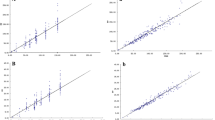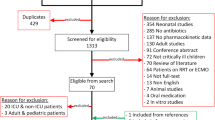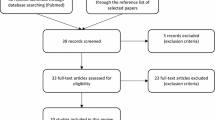Abstract
Piperacillin-tazobactam is a potent β-lactam/β-lactamase inhibitor antibiotic commonly prescribed in the intensive care unit setting. Admitted patients often show large variability in treatment response due to multiple pathophysiological changes present in this population that alter the drug’s pharmacokinetics. This review summarizes the population pharmacokinetic models developed for piperacillin-tazobactam and provides comprehensive data on current dosing strategies while identifying significant covariates in critically ill patients. A literature search on the PubMed database was conducted, from its inception to July 2020. Relevant articles were retained if they met the defined inclusion/exclusion criteria. A total of ten studies, published between 2009 and 2020, were eligible. One- and two-compartment models were used in two and eight studies, respectively. The lowest estimated piperacillin clearance value was 3.12 L/h, and the highest value was 19.9 L/h. The estimations for volume of distribution varied between 11.2 and 41.2 L. Tazobactam clearance values ranged between 5.1 and 6.78 L/h, and tazobactam volume of distribution values ranged between 17.5 and 76.1 L. The most frequent covariates were creatinine clearance and body weight, each present in four studies. Almost all studies used an exponential approach for the interindividual variability. The highest variability was observed in piperacillin central volume of distribution, at a value of 75.0%. Simulations showed that continuous or extended infusion methods performed better than intermittent administration to achieve appropriate pharmacodynamic targets. This review synthesizes important pharmacokinetic elements for piperacillin-tazobactam in an intensive care unit setting. This will help clinicians better understand changes in the drug’s pharmacokinetic parameters in this specific population.


Similar content being viewed by others
References
Landersdorfer CB, Bulitta JB, Kirkpatrick CM, Kinzig M, Holzgrabe U, Drusano GL, Stephan U, Sörgel F. Population pharmacokinetics of piperacillin at two dose levels: influence of nonlinear pharmacokinetics on the pharmacodynamic profile. Antimicrob Agents Chemother. 2012;56(11):5715–23. https://doi.org/10.1128/AAC.00937-12.
Drawz SM, Bonomo RA. Three decades of beta-lactamase inhibitors. Clin Microbiol Rev. 2010;23(1):160–201. https://doi.org/10.1128/CMR.00037-09.
Hayashi Y, Roberts JA, Paterson DL, Lipman J. Pharmacokinetic evaluation of piperacillin-tazobactam. Expert Opin Drug Metab Toxicol. 2010;6(8):1017–31. https://doi.org/10.1517/17425255.2010.506187.
European Centre for Disease Prevention and Control. Antimicrobial consumption in the EU/EEA: Annual epidemiological report for 2018. 2018. https://www.ecdc.europa.eu/sites/default/files/documents/Antimicrobial-consumption-EU-EEA.pdf.
Cotteret C, Vallières E, Roy H, Ovetchkine P, Longtin J, Bussières JF. Antibiotic consumption and bacterial sensitivity in a teaching hospital: a 5-year study [in French]. Arch Pediatr. 2016;23(10):1040–9. https://doi.org/10.1016/j.arcped.2016.07.004.
Craig WA. Pharmacokinetic/pharmacodynamic parameters: rationale for antibacterial dosing of mice and men. Clin Infect Dis. 1998;26(1):1–10. https://doi.org/10.1086/516284 (quiz 11-2).
Guilhaumou R, Benaboud S, Bennis Y, Dahyot-Fizelier C, Dailly E, Gandia P, et al. Optimization of the treatment with beta-lactam antibiotics in critically ill patients-guidelines from the French Society of Pharmacology and Therapeutics (Société Française de Pharmacologie et Thérapeutique-SFPT) and the French Society of Anaesthesia and Intensive Care Medicine (Société Française d’Anesthésie et Réanimation-SFAR). Crit Care. 2019;23(1):104. https://doi.org/10.1186/s13054-019-2378-9.
Blot SI, Pea F, Lipman J. The effect of pathophysiology on pharmacokinetics in the critically ill patient–concepts appraised by the example of antimicrobial agents. Adv Drug Deliv Rev. 2014;77:3–11. https://doi.org/10.1016/j.addr.2014.07.006.
Tängdén T, Ramos Martín V, Felton TW, Nielsen EI, Marchand S, Brüggemann RJ, et al.; Infection Section for the European Society of Intensive Care Medicine, the Pharmacokinetics and Pharmacodynamics Study Group of the European Society of Clinical Microbiology and Infectious Diseases, the International Society of Anti-Infective Pharmacology and the Critically Ill Patients Study Group of European Society of Clinical Microbiology and Infectious Diseases. The role of infection models and PK/PD modelling for optimising care of critically ill patients with severe infections. Intensive Care Med. 2017;43(7):1021-1032. https://doi.org/10.1007/s00134-017-4780-6.
Roberts JA, Lipman J. Pharmacokinetic issues for antibiotics in the critically ill patient. Crit Care Med. 2009;37(3):840–51. https://doi.org/10.1097/CCM.0b013e3181961bff.
Roberts JA, Norris R, Paterson DL, Martin JH. Therapeutic drug monitoring of antimicrobials. Br J Clin Pharmacol. 2012;73(1):27–36. https://doi.org/10.1111/j.1365-2125.2011.04080.x.
Abdul-Aziz MH, Alffenaar JC, Bassetti M, Bracht H, Dimopoulos G, Marriott D, et al. Infection Section of European Society of Intensive Care Medicine (ESICM). Pharmacokinetic/pharmacodynamic and Critically Ill Patient Study Groups of European Society of Clinical Microbiology and Infectious Diseases (ESCMID); Infectious Diseases Group of International Association of Therapeutic Drug Monitoring and Clinical Toxicology (IATDMCT); Infections in the ICU and Sepsis Working Group of International Society of Antimicrobial Chemotherapy (ISAC). Antimicrobial therapeutic drug monitoring in critically ill adult patients: a Position Paper. Intensive Care Med. 2020;46(6):1127-1153. https://doi.org/10.1007/s00134-020-06050-1.
MacArthur RD, Miller M, Albertson T, Panacek E, Johnson D, Teoh L, Barchuk W. Adequacy of early empiric antibiotic treatment and survival in severe sepsis: experience from the MONARCS trial. Clin Infect Dis. 2004;38(2):284–8. https://doi.org/10.1086/379825.
Roberts JA, Abdul-Aziz MH, Lipman J, Mouton JW, Vinks AA, Felton TW, et al.; International Society of Anti-Infective Pharmacology and the Pharmacokinetics and Pharmacodynamics Study Group of the European Society of Clinical Microbiology and Infectious Diseases. Individualised antibiotic dosing for patients who are critically ill: challenges and potential solutions. Lancet Infect Dis. 2014;14(6):498–509. https://doi.org/10.1016/S1473-3099(14)70036-2.
Roberts JA, Paul SK, Akova M, Bassetti M, De Waele JJ, Dimopoulos G, et al.; DALI Study. DALI: defining antibiotic levels in intensive care unit patients: are current β-lactam antibiotic doses sufficient for critically ill patients? Clin Infect Dis. 2014;58(8):1072–83. https://doi.org/10.1093/cid/ciu027.
Richter DC, Frey O, Röhr A, Roberts JA, Köberer A, Fuchs T, et al. Therapeutic drug monitoring-guided continuous infusion of piperacillin/tazobactam significantly improves pharmacokinetic target attainment in critically ill patients: a retrospective analysis of four years of clinical experience. Infection. 2019;47(6):1001–11. https://doi.org/10.1007/s15010-019-01352-z.
Bloos F, Rüddel H, Thomas-Rüddel D, Schwarzkopf D, Pausch C, Harbarth S, et al.; MEDUSA study group. Effect of a multifaceted educational intervention for anti-infectious measures on sepsis mortality: a cluster randomized trial. Intensive Care Med. 2017;43(11):1602-1612. htthttps://doi.org/10.1007/s00134-017-4782-4
Hayashi Y, Lipman J, Udy AA, Ng M, McWhinney B, Ungerer J, et al. β-Lactam therapeutic drug monitoring in the critically ill: optimising drug exposure in patients with fluctuating renal function and hypoalbuminaemia. Int J Antimicrob Agents. 2013;41(2):162–6. https://doi.org/10.1016/j.ijantimicag.2012.10.002.
Muller AE, Huttner B, Huttner A. Therapeutic drug monitoring of beta-lactams and other antibiotics in the intensive care unit: which agents, which patients and which infections? Drugs. 2018;78:439–51. https://doi.org/10.1007/s40265-018-0880-z.
Roberts JA, Kirkpatrick CMJ, Lipman J. Monte Carlo simulations: maximizing antibiotic pharmacokinetic data to optimize clinical practice for critically ill patients. J Antimicrob Chemother. 2011;66(2):227–31. https://doi.org/10.1093/jac/dkq449.
Moher D, Liberati A, Tetzlaff J, Altman DG, The PRISMA Group. Preferred reporting items for systematic reviews and meta-analyses: the PRISMA Statement. PLOS Med.2009;6(7):e1000097. https://doi.org/10.1371/journal.pmed.1000097.
Asín-Prieto E, Rodríguez-Gascón A, Trocóniz IF, Soraluce A, Maynar J, Sánchez-Izquierdo JÁ, et al. Population pharmacokinetics of piperacillin and tazobactam in critically ill patients undergoing continuous renal replacement therapy: application to pharmacokinetic/pharmacodynamic analysis. J Antimicrob Chemother. 2014;69(1):180–9. https://doi.org/10.1093/jac/dkt304.
Bue M, Sou T, Okkels ASL, Hanberg P, Thorsted A, Friberg LE, et al. Population pharmacokinetics of piperacillin in plasma and subcutaneous tissue in patients on continuous renal replacement therapy. Int J Infect Dis. 2020;92:133–40. https://doi.org/10.1016/j.ijid.2020.01.010.
Roberts DM, Liu X, Roberts JA, et al. A multicenter study on the effect of continuous hemodiafiltration intensity on antibiotic pharmacokinetics. Crit Care. 2015. https://doi.org/10.1186/s13054-015-0818-8.
Tamme K, Oselin K, Kipper K, Tasa T, Metsvaht T, Karjagin J, et al. Pharmacokinetics and pharmacodynamics of piperacillin/tazobactam during high volume haemodiafiltration in patients with septic shock. Acta Anaesthesiol Scand. 2016;60(2):230–40. https://doi.org/10.1111/aas.12629.
Ulldemolins M, Martín-Loeches I, Llauradó-Serra M, Fernández J, Vaquer S, Rodríguez A, et al. Piperacillin population pharmacokinetics in critically ill patients with multiple organ dysfunction syndrome receiving continuous venovenous haemodiafiltration: effect of type of dialysis membrane on dosing requirements. J Antimicrob Chemother. 2016;71(6):1651–9. https://doi.org/10.1093/jac/dkv503.
Öbrink-Hansen K, Juul RV, Storgaard M, Thomsen MK, Hardlei TF, Brock B, et al. Population pharmacokinetics of piperacillin in the early phase of septic shock: does standard dosing result in therapeutic plasma concentrations? Antimicrob Agents Chemother. 2015;59(11):7018–26. https://doi.org/10.1128/AAC.01347-15.
Roberts JA, Kirkpatrick CM, Roberts MS, Dalley AJ, Lipman J. First-dose and steady-state population pharmacokinetics and pharmacodynamics of piperacillin by continuous or intermittent dosing in critically ill patients with sepsis. Int J Antimicrob Agents. 2009;35(2):156–63. https://doi.org/10.1016/j.ijantimicag.2009.10.008.
Sukarnjanaset W, Jaruratanasirikul S, Wattanavijitkul T. Population pharmacokinetics and pharmacodynamics of piperacillin in critically ill patients during the early phase of sepsis. J Pharmacokinet Pharmacodyn. 2019;46:251–61. https://doi.org/10.1007/s10928-019-09633-8.
Udy AA, Lipman J, Jarrett P, Klein K, Wallis SC, Patel K, et al. Are standard doses of piperacillin sufficient for critically ill patients with augmented creatinine clearance? Crit Care. 2015;19(1):28. https://doi.org/10.1186/s13054-015-0750-y.
Klastrup V, Thorsted A, Storgaard M, Christensen S, Friberg LE, Öbrink-Hansen K. Population pharmacokinetics of piperacillin following continuous infusion in critically Ill patients and impact of renal function on target attainment. Antimicrob Agents Chemother. 2020;64(7):e02556-e2619. https://doi.org/10.1128/AAC.02556-19.
Li Z, Chen Y, Li Q, Cao D, Shi W, Cao Y, et al. Population pharmacokinetics of piperacillin/tazobactam in neonates and young infants. Eur J Clin Pharmacol. 2013;69(6):1223–33. https://doi.org/10.1007/s00228-012-1413-4.
Delattre IK, Musuamba FT, Jacqmin P, Taccone FS, Laterre PF, Verbeeck RK, et al. Population pharmacokinetics of four β-lactams in critically ill septic patients comedicated with amikacin. Clin Biochem. 2012;45(10–11):780–6. https://doi.org/10.1016/j.clinbiochem.2012.03.030.
Cies JJ, Shankar V, Schlichting C, Kuti JL. Population pharmacokinetics of piperacillin/tazobactam in critically ill young children. Pediatr Infect Dis J. 2014;33(2):168–73. https://doi.org/10.1097/INF.0b013e3182a743c7.
Akers KS, Niece KL, Chung KK, Cannon JW, Cota JM, Murray CK. Modified Augmented Renal Clearance score predicts rapid piperacillin and tazobactam clearance in critically ill surgery and trauma patients. J Trauma Acute Care Surg. 2014;77(3 Suppl 2):S163–70. https://doi.org/10.1097/TA.0000000000000191.
Felton TW, Roberts JA, Lodise TP, Van Guilder M, Boselli E, Neely MN, et al. Individualization of piperacillin dosing for critically ill patients: dosing software to optimize antimicrobial therapy. Antimicrob Agents Chemother. 2014;58(7):4094–102. https://doi.org/10.1128/AAC.02664-14.
Felton TW, McCalman K, Malagon I, Isalska B, Whalley S, Goodwin J, et al. Pulmonary penetration of piperacillin and tazobactam in critically ill patients. Clin Pharmacol Ther. 2014;96(4):438–48. https://doi.org/10.1038/clpt.2014.131.
Nichols K, Chung EK, Knoderer CA, Buenger LE, Healy DP, Dees J, et al. Population pharmacokinetics and pharmacodynamics of extended-infusion piperacillin and tazobactam in critically Ill children. Antimicrob Agents Chemother. 2015;60(1):522–31. https://doi.org/10.1128/AAC.02089-15.
Tsai D, Stewart P, Goud R, Gourley S, Hewagama S, Krishnaswamy S, et al. Pharmacokinetics of piperacillin in critically Ill Australian indigenous patients with severe sepsis. Antimicrob Agents Chemother. 2016;60(12):7402–6. https://doi.org/10.1128/AAC.01657-16.
Alobaid AS, Wallis SC, Jarrett P, Starr T, Stuart J, Lassig-Smith M, et al. Population pharmacokinetics of piperacillin in nonobese, obese, and morbidly obese critically ill patients. Antimicrob Agents Chemother. 2017;61(3):e01276-e1316. https://doi.org/10.1128/AAC.01276-16.
De Cock PAJG, van Dijkman SC, de Jaeger A, Willems J, Carlier M, Verstraete AG, et al. Dose optimization of piperacillin/tazobactam in critically ill children. J Antimicrob Chemother. 2017;72(7):2002–11. https://doi.org/10.1093/jac/dkx093.
Salerno S, Hornik CP, Cohen-Wolkowiez M, Smith PB, Ku LC, Kelly MS, et al., Best Pharmaceuticals for Children Act–Pediatric Trials Network Steering Committee. Use of population pharmacokinetics and electronic health records to assess piperacillin-tazobactam safety in infants. Pediatr Infect Dis J. 2017;36(9):855-859. https://doi.org/10.1097/INF.0000000000001610.
Dhaese SAM, Roberts JA, Carlier M, Verstraete AG, Stove V, De Waele JJ. Population pharmacokinetics of continuous infusion of piperacillin in critically ill patients. Int J Antimicrob Agents. 2018;51(4):594–600. https://doi.org/10.1016/j.ijantimicag.2017.12.015.
Felton TW, Ogungbenro K, Boselli E, Hope WW, Rodvold KA. Comparison of piperacillin exposure in the lungs of critically ill patients and healthy volunteers. J Antimicrob Chemother. 2018;73(5):1340–7. https://doi.org/10.1093/jac/dkx541.
Kanji S, Roberts JA, Xie J, Alobaid A, Zelenitsky S, Hiremath S, et al. Piperacillin population pharmacokinetics in critically ill adults during sustained low-efficiency dialysis. Ann Pharmacother. 2018;52(10):965–73. https://doi.org/10.1177/1060028018773771.
Béranger A, Benaboud S, Urien S, Moulin F, Bille E, Lesage F, et al. Piperacillin population pharmacokinetics and dosing regimen optimization in critically ill children with normal and augmented renal clearance. Clin Pharmacokinet. 2019;58(2):223–33. https://doi.org/10.1007/s40262-018-0682-1.
Rudnick W, Science M, Thirion DJG, et al. Antimicrobial use among adult inpatients at hospital sites within the Canadian Nosocomial Infection Surveillance Program: 2009 to 2016. Antimicrob Resist Infect Control. 2020;9(1):32. https://doi.org/10.1186/s13756-020-0684-2.
Fowler RA, Sabur N, Li P, Juurlink DN, Pinto R, Hladunewich MA, et al. Sex-and age-based differences in the delivery and outcomes of critical care. CMAJ. 2007;177(12):1513–9. https://doi.org/10.1503/cmaj.071112.
Romo H, Amaral AC, Vincent JL. Effect of patient sex on intensive care unit survival. Arch Intern Med. 2004;164(1):61–5. https://doi.org/10.1001/archinte.164.1.61.
Reinikainen M, Niskanen M, Uusaro A, Ruokonen E. Impact of gender on treatment and outcome of ICU patients. Acta Anaesthesiol Scand. 2005;49(7):984–90. https://doi.org/10.1111/j.1399-6576.2005.00759.x.
O’Brien Z, Cass A, Cole L, et al. Sex and mortality in septic severe acute kidney injury. J Crit Care. 2019;49:70–6. https://doi.org/10.1016/j.jcrc.2018.10.017.
Sörgel F, Kinzig M. Pharmacokinetic characteristics of piperacillin/tazobactam. Intensive Care Med. 1994;20(Suppl 3):S14-20. https://doi.org/10.1007/BF01745246.
Bulitta JB, Kinzig M, Jakob V, Holzgrabe U, Sörgel F, Holford NH. Nonlinear pharmacokinetics of piperacillin in healthy volunteers–implications for optimal dosage regimens. Br J Clin Pharmacol. 2010;70(5):682–93. https://doi.org/10.1111/j.1365-2125.2010.03750.x.
De Schepper PJ, Tjandramaga TB, Mullie A, Verbesselt R, van Hecken A, Verberckmoes R, et al. Comparative pharmacokinetics of piperacillin in normals and in patients with renal failure. J Antimicrob Chemother. 1982;9(Suppl B):49–57. https://doi.org/10.1093/jac/9.suppl_b.49.
Arzuaga A, Maynar J, Gascón AR, Isla A, Corral E, Fonseca F, et al. Influence of renal function on the pharmacokinetics of piperacillin/tazobactam in intensive care unit patients during continuous venovenous hemofiltration. J Clin Pharmacol. 2020;45(2):168–76. https://doi.org/10.1177/0091270004269796.
Pistolesi V, Morabito S, Di Mario F, Regolisti G, Cantarelli C, Fiaccadori E. A guide to understanding antimicrobial drug dosing in critically ill patients on renal replacement therapy. Antimicrob Agents Chemother. 2019;63(8):e00583-e619. https://doi.org/10.1128/AAC.00583-19.
Chen IH, Nicolau DP. Augmented renal clearance and how to augment antibiotic dosing. Antibiotics (Basel). 2020;9(7):393. https://doi.org/10.3390/antibiotics9070393.
Jelliffe R. Estimation of creatinine clearance in patients with unstable renal function, without a urine specimen. Am J Nephrol. 2002;22(4):320–4. https://doi.org/10.1159/000065221.
Taccone FS, Laterre PF, Dugernier T, Spapen H, Delattre I, Wittebole X, et al. Insufficient β-lactam concentrations in the early phase of severe sepsis and septic shock. Crit Care. 2010;14(4):R126. https://doi.org/10.1186/cc9091.
Seyler L, Cotton F, Taccone FS, De Backer D, Macours P, Vincent JL, et al. Recommended β-lactam regimens are inadequate in septic patients treated with continuous renal replacement therapy. Crit Care. 2011;15(3):R137. https://doi.org/10.1186/cc10257.
Liu Q, Rand K, Derendorf H. Impact of tazobactam pharmacokinetics on the antimicrobial effect of piperacillin-tazobactam combinations. Int J Antimicrob Agents. 2004;23(5):494–7. https://doi.org/10.1016/j.ijantimicag.2003.10.012.
Nicasio AM, VanScoy BD, Mendes RE, et al. Pharmacokinetics-pharmacodynamics of tazobactam in combination with piperacillin in an in vitro Infection Model. Antimicrob Agents Chemother. 2016;60(4):2075–80. https://doi.org/10.1128/AAC.02747-15.
Kalaria SN, Gopalakrishnan M, Heil EL. A population pharmacokinetics and pharmacodynamic approach to optimize tazobactam activity in critically ill patients. Antimicrob Agents Chemother. 2020;64(3):e02093-e2119. https://doi.org/10.1128/AAC.02093-19.
Komuro M, Maeda T, Kakuo H, Matsushita H, Shimada J. Inhibition of the renal excretion of tazobactam by piperacillin. J Antimicrob Chemother. 1994;34(4):555–64. https://doi.org/10.1093/jac/34.4.555.
Lodise TP, Lomaestro BM, Drusano GL, Society of Infectious Diseases Pharmacists. Application of antimicrobial pharmacodynamic concepts into clinical practice: focus on beta-lactam antibiotics: insights from the Society of Infectious Diseases Pharmacists. Pharmacotherapy. 2006;26(9):1320–32. https://doi.org/10.1592/phco.26.9.1320.
Pea F, Viale P. Bench-to-bedside review: appropriate antibiotic therapy in severe sepsis and septic shock–does the dose matter? Crit Care. 2009;13(3):214. https://doi.org/10.1186/cc7774.
Abdul-Aziz MH, Dulhunty JM, Bellomo R, Lipman J, Roberts JA. Continuous beta-lactam infusion in critically ill patients: the clinical evidence. Ann Intensive Care. 2012;2(1):37. https://doi.org/10.1186/2110-5820-2-37.
Falagas ME, Tansarli GS, Ikawa K, Vardakas KZ. Clinical outcomes with extended or continuous versus short-term intravenous infusion of carbapenems and piperacillin/tazobactam: a systematic review and meta-analysis. Clin Infect Dis. 2013;56(2):272–82. https://doi.org/10.1093/cid/cis857.
Roberts JA, Lipman J, Blot S, Rello J. Better outcomes through continuous infusion of time-dependent antibiotics to critically ill patients? Curr Opin Crit Care. 2008;14(4):390–6. https://doi.org/10.1097/MCC.0b013e3283021b3a.
Fawaz S, Barton S, Nabhani-Gebara S. Comparing clinical outcomes of piperacillin-tazobactam administration and dosage strategies in critically ill adult patients: a systematic review and meta-analysis. BMC Infect Dis. 2020;20(1):430. https://doi.org/10.1186/s12879-020-05149-6.
Dulhunty JM, Roberts JA, Davis JS, Webb SA, Bellomo R, Gomersall C, et al., BLING II Investigators for the ANZICS Clinical Trials Group *. A Multicenter Randomized Trial of Continuous versus Intermittent β-Lactam Infusion in Severe Sepsis. Am J Respir Crit Care Med. 2015;192(11):1298–305. https://doi.org/10.1164/rccm.201505-0857OC.
Abdul-Aziz MH, Sulaiman H, Mat-Nor MB, Rai V, Wong KK, Hasan MS, et al. Beta-Lactam Infusion in Severe Sepsis (BLISS): a prospective, two-centre, open-labelled randomised controlled trial of continuous versus intermittent beta-lactam infusion in critically ill patients with severe sepsis. Intensive Care Med. 2016;42(10):1535–45. https://doi.org/10.1007/s00134-015-4188-0(Epub2016).
Lipman J, Brett SJ, De Waele JJ, Cotta MO, Davis JS, Finfer S, et al. A protocol for a phase 3 multicentre randomised controlled trial of continuous versus intermittent β-lactam antibiotic infusion in critically ill patients with sepsis: BLING III. Crit Care Resusc. 2019;21(1):63–8.
Author information
Authors and Affiliations
Corresponding author
Ethics declarations
Funding
No sources of funding were used to assist in the preparation of this review.
Conflict of Interest
Ibrahim El-Haffaf received a scholarship from Université de Montréal. Amélie Marsot acknowledges support from the Fonds de Recherche du Québec-Santé (FRQS) Research Scholars – Junior 1 (Young Researcher Establishment) Career Scholarship and the Fonds Servier – Faculty of Pharmacy, Université de Montréal. Jean-Alexandre Caissy has no conflicts of interest to declare.
Ethics approval
Not applicable.
Consent to participate
Not applicable.
Consent for publication
Not applicable.
Availability of data and material
Data was collected from the already published articles in the literature. Data generated to realize the various graphical analysis are not publicly available.
Code availability
Not applicable.
Author’s contributions
IE analyzed the data. IE wrote the manuscript. JC and AM validated the manuscript. AM supervised the work. All authors read and approved the final manuscript.
Supplementary Information
Below is the link to the electronic supplementary material.
Rights and permissions
About this article
Cite this article
El-Haffaf, I., Caissy, JA. & Marsot, A. Piperacillin-Tazobactam in Intensive Care Units: A Review of Population Pharmacokinetic Analyses. Clin Pharmacokinet 60, 855–875 (2021). https://doi.org/10.1007/s40262-021-01013-1
Accepted:
Published:
Issue Date:
DOI: https://doi.org/10.1007/s40262-021-01013-1




